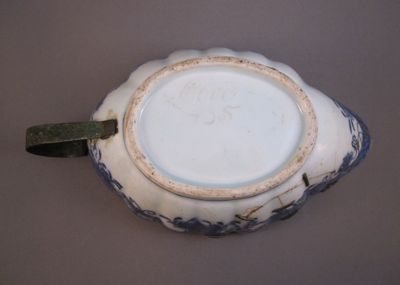I have often expressed that I am a sucker for pieces containing more than one form of early repair and this little beauty does not disappoint, as it sports three separate repairs and a signature to boot. Chinese porcelain sauceboat, made for export in the mid-1700s, was originally part of a large dinner set consisting of up to dozens of place settings and serving pieces, including a matching pair of sauceboats. Painted with cobalt blue underglaze in the Nanking pattern, it measures 7-3/4″ long from end to end and is 4-1/4″ deep.
Repair #1: Metal replacement handle, which may have once been covered in woven reed, was riveted to the end of the sauceboat, echoing the loop form of the original.
Repair #2: After the sauceboat was dropped a second time, an eighteenth century china mender carefully applied six 1/2″ staples to adhere the two large broken pieces near the spout.
Repair #3: Three tiny 1/4″ metal staples affix another large piece which broke off at the end of the sauceboat. They were overpainted in blue to match the decoration and over one hundred years later have held up quite well.
Etched on the bottom is “Cove 835”, which I am assuming is the mark of the china mender or tinker who was responsible for one or more of the repairs. I have not been able to find out any information on this cryptic signature but will continue to search and I welcome information anyone can provide.
This porcelain sauce boat from the same period shows what the simple loop handle on my piece would have looked like, before the addition of the metal replacement handle.
Photo courtesy of Ruby Lane
Tags: blue & white, Chinese, metal handle, porcelain, staples/rivets









Just lovely…
Could you explain the technique? Drill holes etc? Soft metal etc. glues.
What a treasure. Made me sigh.
please enter “How did they do that?” into the search box (on the right side under SUBSCRIBE), and you can read an entry which best explains the delicate procedure.